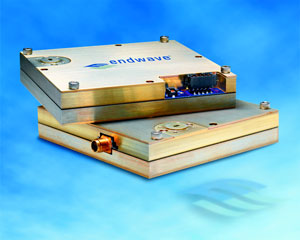MTT-S 2009: Endwave Launches High Volume, Advanced e-band TX/RX Pair

Endwave Corporation, a leading provider of high-frequency RF devices and integrated subsystems, has announced that their advanced E-band TX/RX pair is now available in high volumes. Endwave's transmit-receive (TX/RX) module pair is a uniquely integrated subsystem that incorporates several Endwave innovations. They operate over the E-band frequency spectrum from 71.0-86.0 GHz and are designed for broadband point-to-point radios carrying voice and data traffic at multi-gigabit per second rates. With several prototypes working effectively in the field, first volume production runs have begun.
The typical performance of Endwave's TX module includes a conversion gain of 15 dB and an output power of 16 dBm, with an integrated power detector on the TX output. (Higher power transmitter options are also available.) Endwave's E-band RX module provides a noise figure of 9 dB, better than 25 dB of RF-to-IF conversion gain, and an input one dB compression point (P1dB) of -25 dBm. Separate models cover the 71-76 GHz and 81-86 GHz operating bands.
Both TX and RX modules use Endwave's MLMS sub-harmonic mixer topology that provides a single level of conversion direct from E-Band to IF. This mixer design provides functionality and performance that is not available in MMIC format today. This architecture also significantly reduces the cost of the local oscillator (LO) circuit chain relative to the costs of comparable fundamental mixer approaches.
These E-band TX/RX modules are the first ever to employ both of Endwave's newest proprietary technologies, MLMS and Epsilon Packaging, in a single RF subsystem. These innovations facilitate small size and low cost. With successful implementation on these E-Band products, the viability of these technologies in applications from low RF frequencies to over 100 GHz is proven.
Additional features of the pair include support of modulation formats ranging from on/off keying to 16 QAM modulation, a sub-harmonically pumped TX/RX architecture and an on-board micro-controller for software controlled compensation. Options include closed-loop AGC on TX output (up to 10 dB range) and customized VCO-based synthesizers to drive the up-conversion and down-conversion processes in the TX and RX, respectively.
 E-band radio links offer a compelling alternative to terrestrial fiber optic cable in a variety of commercial, military, and government end-use applications. These include: ubiquitous high-speed networks for business and campus environments; virtual private networks (VPNs); systems for carrier loop diversity and disaster recovery from central office to large office buildings; routing by cable operators (MSOs) of commercial Ethernet to extend coverage out to large building complexes; high-data-rate backhaul for cellular, WiMax, and WISP (wireless internet service provider) operators; HDTV signal routing; and other fiber substitution applications.
E-band radio links offer a compelling alternative to terrestrial fiber optic cable in a variety of commercial, military, and government end-use applications. These include: ubiquitous high-speed networks for business and campus environments; virtual private networks (VPNs); systems for carrier loop diversity and disaster recovery from central office to large office buildings; routing by cable operators (MSOs) of commercial Ethernet to extend coverage out to large building complexes; high-data-rate backhaul for cellular, WiMax, and WISP (wireless internet service provider) operators; HDTV signal routing; and other fiber substitution applications.
The advantages of wireless E-band links versus wired fiber-optic solutions include substantially lower deployment costs, deployment speeds that are measured in days (rather than months, or even a year for fiber), and reduced regulatory and environmental approval burdens.
About Endwave
Endwave Corporation designs, manufactures and markets RF modules that enable the transmission, reception and processing of high-frequency signals. As one of the largest suppliers of microwave point-to-point radio subsystems, Endwave is experienced in integrated transmit and receive modules that function in the millimeter wave frequency range. Endwave has 42 issued patents covering its core technologies including semiconductor and proprietary circuit designs. Corporate headquarters are located in San Jose, CA, with other operations in Salem, NH; and Chiang Mai, Thailand.
SOURCE: Endwave Corporation
